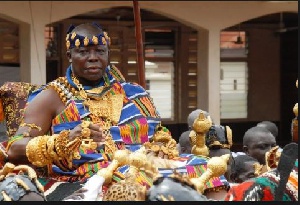By Rockson Adofo
Someone who claims to be closely following my discourses on the Kumawu chieftaincy dispute with keen interest recently questioned me about my understanding, and subsequent refusal, of, the Asantehene's overlordship in Asanteman. I intentionally denied him an immediate answer but requested him to continue to follow me on the internet if indeed, he has been as he alleges.
Why did I not instantaneously volunteer the answer as the seeming inquisitor had wanted to quench his appetite, and, or curiosity, for historic knowledge? I did not give him the answer there and then because I doubted if he had been reading my publications as he asserts. If he has, he might not be the only one who is probably confused about whether or not Asantehene is indeed the Overlord of Asanteman hence I assured him to continue to read my published articles as I would soon address his concern by usual publication hence this article today.
To begin with, we need to understand what are Asanteman and overlordship. Asanteman
refers to the union of then independent States that came together to form a
formidable power and State to fight the common enemy or enemies of those States under
the august leadership of Nana Osei Tutu II, the Kumasihene, on the advice of, and
instigation by, the renowned fetish priest Akomfo Anokye. The members of this union
of loose States came to owe common allegiance to the conjured up Golden Stool, the
symbol of unity, by Okomfo Anokye. Then came the need to find among the independent
paramount chiefs bringing their areas of jurisdiction into the union one person to be
their leader.
A point of interest to be noted by public readers or history students. The Asanteman
chiefs do not owe allegiance to the occupant of the Golden Stool (Asantehene) but to
the Golden Stool itself.
This search of leadership came about with the historic planting of two KUM seedlings,
one at then Kwamang now called Kumasi and the other at Apemso, now Kumawu. Out of the
two seedlings whichever between the two thrived would become the headquarters of the
Union with its paramount chief becoming the head of the Union. That of Kwamang,
headed by Nana Osei Tutu I thrived hence Kwamang becoming Kumasi while that of Apemso withered, therefore the place been renamed Kumawu, thus, the Kum tree has died.
The renaming of the two places came about as a result of people saying, me reko
kum no ase (I am going under the Kum tree) hence Kum ase, and me reko kum no a
awu no ho (I am going to where the kum tree has died) hence kum awu.
I do not want to go into the details of Asanteman as that is not the subject matter of today's write-up but Asantehene's Overlordship. Nonetheless, readers must take note that during that period of Asante's supremacy at the battlefield, conquering their enemies and expanding their territories, the Union was called Asante Confederacy. It was abrogated by the British Colonial government in 1896 when they captured and exiled then reigning Asantehene Otumfuo Agyemang Prempeh I to Seychelles via Sierra Leone. Upon his repatriation to Gold Coast or Ashanti in 1926 and the restoration of the Asante Confederacy in 1935, the Asante Confederacy was later to be
changed to Asanteman Council.
Who is an Overlord? The dictionary and other references pertaining to our past, will be of immense help to defining to the understanding of any ordinary person without scholarly knowledge what overlordship or Overlord is. According to the Cambridge dictionary, Overlord is a person in a position of power, especially in the past;
People in charge of or controlling other people. By the Dictionary.com, an Overlord is a person who is lord over another or over other lords: a person of great influence, authority, power, or the like: to rule or govern arbitrarily or tyrannically; domineer.
To answer that person who inquired from me about Asantehene’s overlordship in Asanteman and my refusal to budge to its misconstruction as upheld by many a typically-minded Ashanti who may be lazy to conduct a little scholarly research into the history of the formation, abrogation and restoration of the Asante Confederacy as well as the relevant conventions and regulatory statutes as enshrined in Ghana’s
constitution, I shall say the following:
1. The Overlordship of Asantehene as it was the order of the years, months and
days preceding the capture and deportation of Asantehene Otumfuo Agyemang Prempeh I
to Seychelles, where they had the right to slaughter people to bury their dead
royals, banish subjects who disagreed with them, seize people’s lands and
properties and subjected them to inhumane treatments does no longer exist. Therefore,
the first definition of the Cambridge dictionary as stipulated above is very right.
2. The Overlordship of Asantehene as being in charge of or controlling other
people with reference to the same Cambridge dictionary does not fully pertain in our
today Ghana. I would not like to explain it fully here as I will shortly be writing a
very comprehensive article in which it will be extensively expounded. Who does he
control? If he has that power to control the people of Asanteman very submissively,
would people castigate him so rampantly on the airwaves, in the streets and at any
least opportunity offered them?
3. Yes, going by the definitions of the Dictionary.com, Asantehene and especially,
Otumfuo Osei Tutu II, is an Asante Overlord since by lack of knowledge and other unexplained reasons some paramount chiefs within that loose Union kowtow to him even when he is erring and abusing his powers and insulting their intelligence. By the same dictionary definition, the current Asantehene is governing tyrannically by seizing lands belonging to other States, now called Divisions, within the Asanteman Council. I do not want to discuss this topic into details as I shall soon be taking him on in my next publication.
To conclude, Asantehene is not an overlord of Asanteman in one sense and he is an overlord in another, depending on the context he is viewed in or is being discussed at a point in time. For me as a person, and going by his lamentable attitudes, he is not an overlord of Asanteman as misunderstood by some people who cannot bother themselves to conduct researches into our history dating from 1935 through to Gold Coast becoming Ghana hence a republic, until today where absolute monarchy has been abolished to give way to constitutional monarchy and democracy where the national constitution reigns supreme.
Watch out shortly for my next publication on Asantehene. It will contain shocking
revelations.
Opinions of Friday, 24 February 2017
Columnist: Adofo, Rockson















